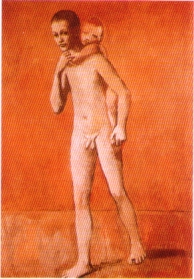-

Picasso's Pink Period 1904-1906
Willem de Kooning found a lot of inspiration for his paintings on works by other Painters, one of them being Picasso.
-
-

b. 1871, Turin; d. 1958, Rome
Giacomo Balla was born in Turin on July 18, 1871. In 1891 he studied briefly at the Accademia Albertina di Belle Arti and the Liceo Artistico in Turin and exhibited for the first time under the aegis of the Società Promotrice di Belle Arti in that city. He studied at the University of Turin with Cesare Lombroso about 1892. In 1895 Balla moved to Rome, where he worked for several years as an illustrator, caricaturist, and portrait painter. In 1899 his work was included in the Venice Biennale and in the Esposizione internazionale di belle arti at the galleries of the Società degli Amatori e Cultori di Belle Arti in Rome, where he exhibited regularly for the next ten years. In 1900 Balla spent seven months in Paris assisting the illustrator Serafino Macchiati. About 1903 he began to instruct Gino Severini and Umberto Boccioni in divisionist painting techniques. In 1903 his work was exhibited at the Esposizione internazionale d’arte della città di Venezia and in 1903 and 1904 at the Glaspalast in Munich. In 1904 Balla was represented in the Internationale Kunstausstellung in Düsseldorf, and in 1909 exhibited at the Salon d’Automne in Paris.
Balla signed the second Futurist painting manifesto of 1910 with Boccioni, Carlo Carrà, Luigi Russolo, and Severini, although he did not exhibit with the group until 1913. In 1912 he traveled to London and to Düsseldorf, where he began painting his abstract light studies. In 1913 Balla participated in the Erste deutsche Herbstsalon at Der Sturm gallery in Berlin and in an exhibition at the Rotterdamsche Kunstkring in Rotterdam. In 1914 he experimented with sculpture for the first time and showed it in the Prima esposizione libera futurista at the Galleria Sprovieri, Rome. He also designed and painted Futurist furniture and designed Futurist “antineutral” clothing. With Fortunato Depero, Balla wrote the manifesto Ricostruzione futurista dell’universo in 1915. His first solo exhibitions were held that same year at the Società Italiana Lampade Elettriche “Z” and at the Sala d’Arte A. Angelelli in Rome. His work was also shown in 1915 at the Panama-Pacific International Exposition in San Francisco. In 1918 he was given a solo show at the Casa d’Arte Bragaglia in Rome. Balla continued to exhibit in Europe and the United States and in 1935 was made a member of the Accademia di San Luca in Rome. He died on March 1, 1958, in Rome.
-

Spanish title: Dios la perdone: Y era su madreEnglish: God forgive her- It was her Mother
The girl left home very young. Her apprenticeship was gotten at Cadiz and then she went to Madrid.
Here she won a lottery prize. She goes for a walk along the Prado.
A dirty, shrivelled hag begs her for alms.
She chases her away, but the old women follows her.
The hard-hearted girl turns around and sees - who would believe?- The poor old women is her mother!MMaxi
-

- Good Advice
- Spanish titel: Bellos Concejos
Advice is worthy of her who takes it. The tragedy is that the girl will follow it to the letter.
Miserable will be the Man who will have anything to do with Her.
-
-
-

b. 1883, Cortona, Italy; d. 1966, Paris
Gino Severini was born April 7, 1883, in Cortona, Italy. He studied at the Scuola Tecnica in Cortona before moving to Rome in 1899. There he attended art classes at the Villa Medici and by 1901 met Umberto Boccioni, who had also recently arrived in Rome and later would be one of the theoreticians of Futurism [more]. Together, Severini and Boccioni visited the studio of Giacomo Balla, where they were introduced to painting with “divided” rather than mixed color. After settling in Paris in November 1906, Severini studied Impressionist painting and met the Neo-Impressionist Paul Signac.
Severini soon came to know most of the Parisian avant-garde, including Georges Braque, Juan Gris, Amedeo Modigliani, and Pablo Picasso; Lugné-Poë and his theatrical circle; the poets Guillaume Apollinaire, Paul Fort, and Max Jacob; and author Jules Romains. After joining the Futurist movement at the invitation of Filippo Tommaso Marinetti and Boccioni, Severini signed the Manifesto tecnico della pittura futurista of April 1910, along with Balla, Boccioni, Carlo Carrà, and Luigi Russolo. However, Severini was less attracted to the subject of the machine than his fellow Futurists and frequently chose the form of the dancer to express Futurist theories of dynamism in art.
Severini helped organize the first Futurist exhibition at Galerie Bernheim-Jeune, Paris, in February 1912, and participated in subsequent Futurist shows in Europe and the United States. In 1913, he had solo exhibitions at the Marlborough Gallery, London, and Der Sturm, Berlin. During the Futurist period, Severini acted as an important link between artists in France and Italy. After his last truly Futurist works—a series of paintings on war themes—Severini painted in a Synthetic Cubist mode, and by 1920 he was applying theories of classical balance based on the Golden Section to figurative subjects from the traditional commedia dell’arte. He divided his time between Paris and Rome after 1920. He explored fresco and mosaic techniques and executed murals in various mediums in Switzerland, France, and Italy during the 1920s. In the 1950s, he returned to the subjects of his Futurist years: dancers, light, and movement. Throughout his career, Severini published important theoretical essays and books on art. Severini died February 26, 1966, in Paris.
-
MMaxi on the move









